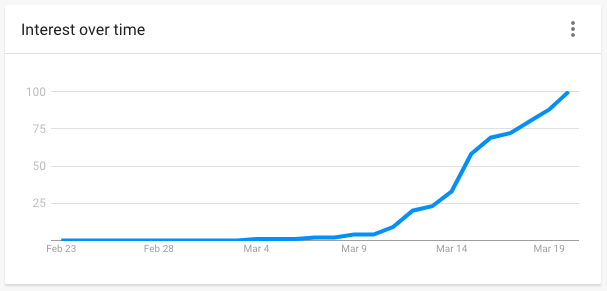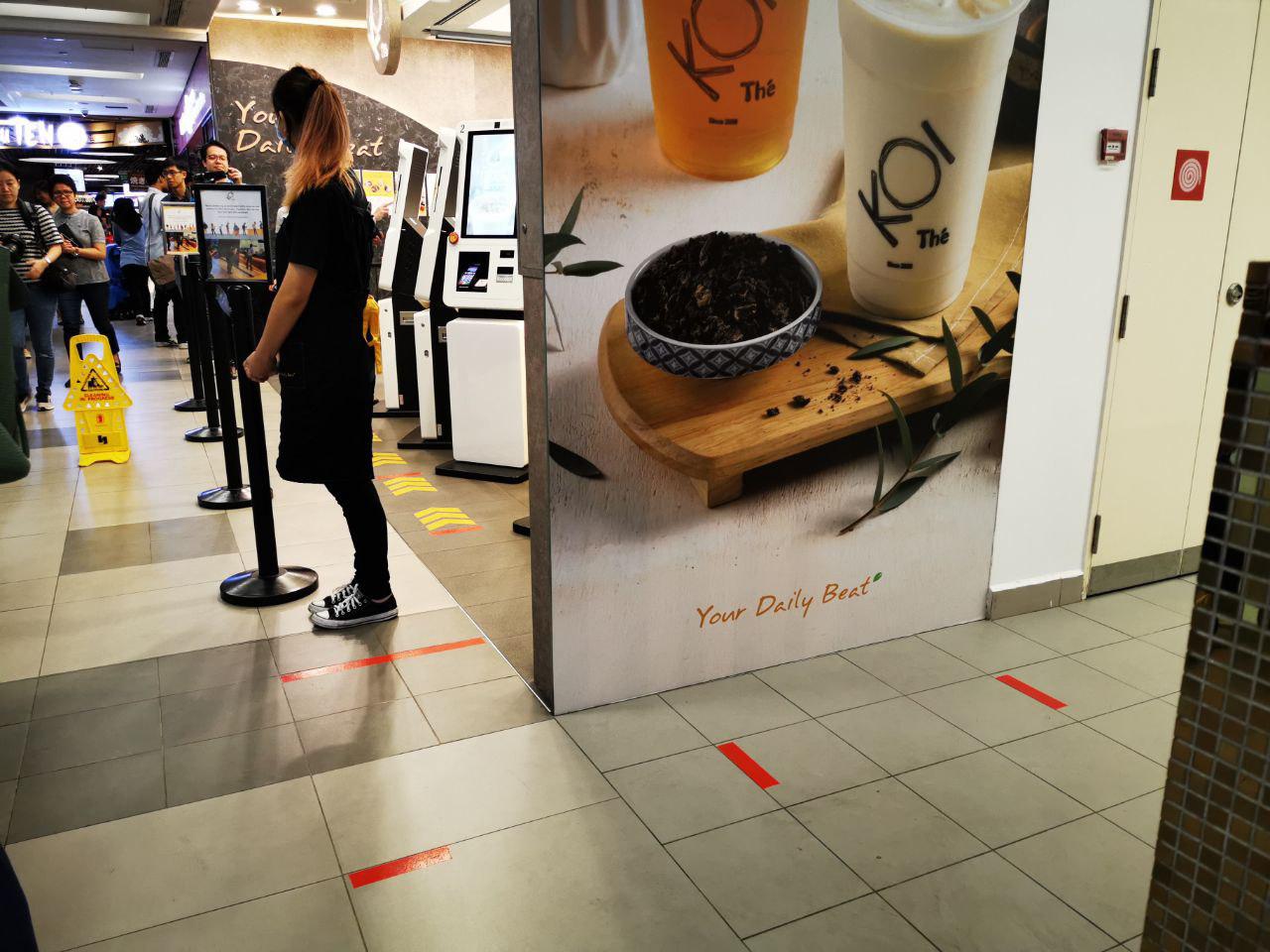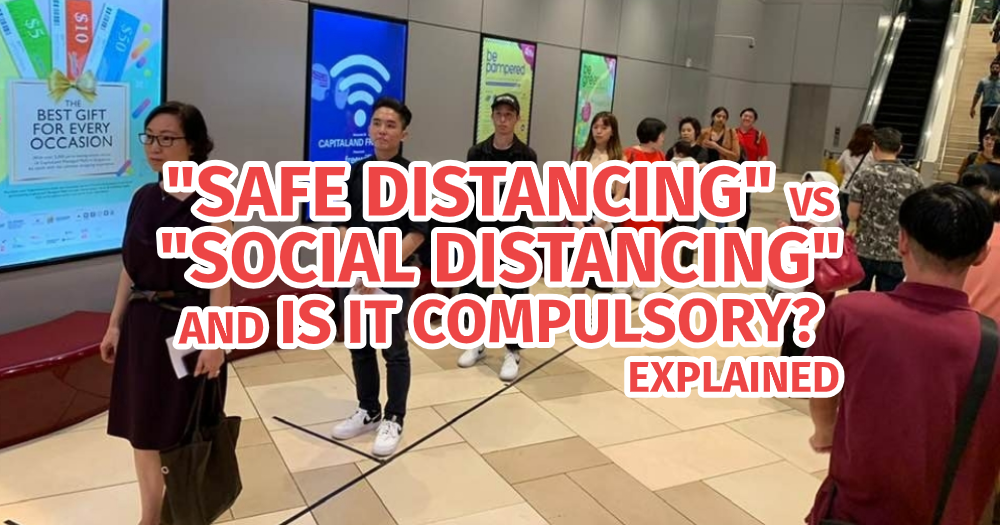[UPDATE at 8:43pm: MOH has announced safe distancing measures such as the closure of entertainment venues in Singapore, suspension of religious services, as well as limiting gatherings outside of work and school to 10 persons or fewer. Bars, clubs, cinemas & tuition centres will also be closed from Mar. 26, 2020. Read more here.]
"Social distancing", a somewhat-familiar term from the SARS era, re-emerged recently.
There has been an uptick in Google searches for the term "social distancing" in the last few weeks.
 Screenshot of Google Trends search for "social distancing".
Screenshot of Google Trends search for "social distancing".
Locally, Singaporeans have exhibited clear examples of what social distancing should look like:
As well as what it should not look like:
But what actually is social distancing?
In short, social distancing "aims to reduce the number of person-to-person contacts in order to slow the spread of infection. This reduces the surge on the medical care system [...] to reduce transmission until an effective vaccine is available."
This makes it "an important public health measure", according to a document from the Ministry of Health (MOH)'s website detailing its "readiness and response plan for novel acute respiratory infections with pandemic potential", dated April 2014.
Social distancing is also listed as one item of advice to the public, in the event of Singapore's DORSCON level going to Red.
[caption id="" align="alignnone" width="1400"] Image via gov.sg.[/caption]
Image via gov.sg.[/caption]
However, the 2014 document explains that "selective social distancing measures may be required in [...] DORSCON Orange".
This is in line with MOH's recent statement that DORSCON categories are general guidelines for action, and are not set in stone, according to The Straits Times.
Indeed, until mid-March, various government agencies and politicians advised the population to practise "social distancing" as a precautionary measure.
A Mar. 14 advisory by the Ministry of Manpower (MOM) mentioned "social distancing" in an advisory to reduce the local spread of Covid-19 at the workplace.
Prime Minister Lee Hsien Loong himself used the term "social distancing" in a televised speech on Mar. 12, citing examples like "suspending school, staggering work hours, or compulsory telecommuting".
Where did "safe distancing" come in? Is there even a difference between "safe" and "social"?
Singaporeans with particular attention to detail would have noticed that besides "social distancing", a new term, "safe distancing", has entered the Singaporean lexicon too.
It's not exactly clear when this change happened, though it seems to have been first used in various government advisories on Mar. 20, such as a MOH press release announcing "stricter safe distancing measures" (emphasis ours).
So far, also, there doesn't appear to be a difference between "safe" or "social" distancing, in terms of the context both terms are being used in.
So why are people trying to change the term being used?
While the change in the terms used was not explained by government agencies here, they are certainly not alone in distancing themselves from the term "social distancing".
At a World Health Organisation (WHO) press conference on Mar. 20, Dr. Maria Van Kerkhove explained that the organisation will start to use "physical distancing" and not "social distancing", "because we want people to still remain connected".
Van Kerkhove also explained that this was to avoid the implication that "we have to disconnect from our loved ones, from our family", even while people are encouraged to maintain physical distance.
As The New York Times puts it, our daily face-to-face interactions are already undermined by technology. Throw in "social distancing" and it might probably do more harm to people who are wired for human connection.
An op-ed on CNN advocated the use of "physical distancing" rather than "social distancing" for similar reasons.
That, perhaps, is why we might be starting to hear more about "safe distancing" from government agencies here in Singapore, even though it will refer to pretty much the same thing as WHO's "physical distancing" or "social distancing", which is the term that has been around the longest.
Is social distancing compulsory?
In short: no, for the most part.
Various sector-specific advisories and statements have been issued by government agencies in Singapore, each talking about social distancing or safe distancing in different areas of life.
In most cases, however, whether or not you need to practice social distancing will come down to common sense, and your own individual judgement.
Compulsory social distancing
There are some cases where it will be, though.
Social distancing is definitely compulsory, for instance, if you are quarantined, or serving out a 14-day Stay-Home Notice.
And if you're sick, polyclinics and Public Health Preparedness Clinics (PHPCs) can provide five-day MCs at subsidised rates, so that you are able to rest and recover at home.There's also no question about social distancing if you are intending to attend events with 250 or more people, senior-centric activities organised by the People's Association, Catholic or Methodist church services, or gatherings in mosques, as all of these have been cancelled for now.
Telecommuting: "strongly advised" but not mandatory
Working from home or telecommuting has not yet been made mandatory, though PM Lee has said that it could at some point be made compulsory, if there is "a spike" in the Covid-19 outbreak here, in a speech he made on Mar. 12.
MOH has "strongly advised" employers to facilitate work-from-home arrangements where possible.
Employers are also advised to implement staggered working hours for both reporting and ending times, which should not coincide with peak-hour travel. This would help reduce the number of people in rush-hour crowds.
This was a suggestion echoed by Transport Minister Khaw Boon Wan on Monday (Mar. 23). Khaw also asked commuters to cut down on unnecessary travel on public transport and try not to talk at all, or softly if they need to, while using it.
Any situations besides these would come down to personal judgement and responsibility.
Can I still go out on weekends?
Yes, of course. But some changes to regular routines should be expected.
F&B outlets and other businesses: one-metre distancing
F&B outlets have been advised to set their seats at least one metre apart from one another, along with other measures such as recording of customers' personal details to facilitate contact tracing.
 Safe distance markings for the queue at Koi's NEX outlet. Photo by Zheng Zhangxin.
Safe distance markings for the queue at Koi's NEX outlet. Photo by Zheng Zhangxin.
Retail outlets have been advised by the Singapore Tourism Board (STB) and Enterprise Singapore (ES) to limit the number of shoppers they allow into their stores or spaces, and ensure customers have enough room to observe a gap of at least one metre between themselves. This can be done by letting customers into the stores progressively, and by marking out queueing positions, for example.
While these are technically not compulsory, they have been made a requirement for businesses, and those who do not comply "may be ineligible for government grants and loan assistance", according to Enterprise Singapore's website.
Events
All events with 250 or more participants have been suspended as of Mar. 20, but events with 249 participants or less are technically allowed to continue, with precautionary measures in place.
Venues such as cinemas have taken steps to reduce close contact between their patrons, with Golden Village relaxing its “no single seat gap” policy, allowing cinema-goers to leave a gap between themselves and others when they buy tickets.
Religious services
Many churches have temporarily suspended regular services, in favour of live-streaming. Catholic and Methodist churches in Singapore announced the suspension of gatherings as well.
Small prayer spaces for up to 20 people will be available at 19 mosques from Mar. 23, the Islamic Religious Council of Singapore (MUIS) announced on its Facebook page.
Other mosques, which are currently closed, will be reopening on Mar. 26 with additional measures, such as a contact tracing regime, put in place.
So it eventually comes down to me?
Ultimately, beyond what is decided by the government, employers, and organisations, there is still plenty of room for Singaporeans to exercise their own judgement in deciding how they want to spend their time.
More importantly, Singaporeans should also note that practising social distancing not only serves to protect ourselves, but also the community around us.
After all, there aren't currently any rules against being the 249th attendee at an event, which could be a tough call if the event was something like a colleague's wedding, for example. And so it falls to each of us to be creative in finding solutions which can be both safe and social.
Mothership Explains is a series where we dig deep into the important, interesting, and confusing going-ons in our world and try to, well, explain them.
This series aims to provide in-depth, easy-to-understand explanations to keep our readers up to date on not just what is going on in the world, but also the "why's".
Top photo adapted from Ho Ching’s Facebook post
If you like what you read, follow us on Facebook, Instagram, Twitter and Telegram to get the latest updates.
